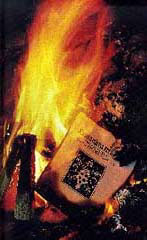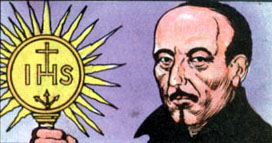The Reformation in Prophecy.
The Book of Revelation (written about 96 A.D.) is a continuation of the Book of Daniel. The symbols are the same and the visions are the same. The Book of Daniel contains a twofold set of prophecies. There are visions of the great world empires that would rule the world up to the first coming of Christ, and there are prophecies of the Temple and the destiny of the people of God up to that time. Throne prophecies followed by Temple prophecies. . . . The Book opens with a special promise of blessing to the readers, and a message of grace and peace from God the Father, the Lord Jesus Christ and the Holy Spirit. The message of grace and peace is the same message that is given in the Book of Galatians - the great epistle on salvation by grace alone. Only those who trust in Christ by faith alone have the blessing of God the Father and the Holy Spirit. The book is a record of things which must shortly come to pass, given in symbols or signs. Daniel's Four Beasts or Empires.
Imperial Rome broke up in 476 A.D., and re-emerged as Papal Rome in the divided kingdom stage. Next comes a series of messages to the seven churches in Asia. The seven churches are representative of the state of the Christian Church during the past 2000 years. They cover the highlights of the entire Old Testament. The Church of Smyra is the Church of the catacombs - the martyr Church - before the ascension of Constantine. The Philadelphia Church - the church of the open door represents the Church of the Protestant Reformation. In the next vision the Apostle John is transported to the glories of Heaven and what occupies the attention of the entire universe? It is JESUS CHRIST the LAMB slain from the foundation of the world. The only sacrifice for sins. . . . He is vested with all authority in Heaven and earth. He must reign in Heaven until He has put all enemies under His feet. The last enemy that shall be destroyed is Death (I Corinthians 15:25). Chapter six introduces the infamous 4 horsemen of the Apocalypse. Horseman number 1 is the Antichrist: who is followed by war, famine, disease, sin, death, hell etc., etc. Chapter 8 begins with the blowing of 6 trumpets warning of dire calamities to fall upon the earth. The scene is the Western Roman Empire:
The scene now shifts to the East, to the desert:
The scene is all of desolation, destruction, false religions, murder, mayhem etc. - and ends on this note:
A more vivid portrait of the Dark Ages and the history of the world during that time could not be painted. The mighty Roman Empire which once stretched from the Atlantic to the Euphrates is extinct, and the scene is set for the next great event - The Reformation. Revelation Chapter 10.The next great vision is a vision of the Temple of God. The mighty Angel that descends from Heaven is none other than Christ Himself - the Angel of the Reformation. Her great Head and Shepherd has returned to rebuild the ruined Temple. This could only be accomplished by the Divine one Himself. "And the Lord descended in the cloud" (Exodus 34:5). He has a rainbow around His head which reminds us of the Flood of Noah. The old world was exceedingly corrupt and God drowned it in a flood of water. Finally, the Dark Ages are over, and God is visiting the earth a second time. The little open book in the Angel's hand is the Bible - the Word of God. Before the invention of printing, books were copied by hand. They were bulky and large. The printing press made them small and easy to carry - and in many cases easily hidden from the Roman Catholic authorities. . . . The first task of the Reformers was to translate The BOOK into the languages of the oppressed, suffering people of Europe. The printing press made it indeed an open book - affordable to the common people - and it was read with great delight by everyone.
and the Reformation message spread rapidly as faithful Christians carried it throughout Europe - in spite of awful suffering and persecution. Multitudes recognized the Papacy as the great falling away from the Apostolic Faith, predicted by the apostle Paul, and they obeyed the Lord's command to:
Christ is the lion of the tribe of Judah (Rev. 5:5) and at the time of the Reformation he cried mightily and his roar was heard throughout the world. However, his authority did not go unchallenged! Sitting in the Vatican at that time was another lion - the false and usurping lion - Pope Leo the Tenth. . . . After Martin Luther posted his 95 Theses, this Pope thundered against him from the Seven Hills, and ordered him to recant or be burned alive! During the Dark Ages, Papal Bulls were called thunders and had the effect of paralyzing whole nations - even bringing kings to their knees! Luther ignored the Bull and even made a bonfire of it . . . with all the Roman Canon Laws . . . and centuries of traditions of men which they had added to Scripture.
Rome's answer to the Reformation was to bring back the Inquisition. The Inquisition was founded in 1233, by a monk named Dominic, but had fallen into disuse - a victim of its own success. It was updated and refurbished, and made fit for this modern emergency. The Bull re-establishing the Inquisition was make on July 21, 1542. The "Holy Office" under the Jesuits, revived with terrors unknown to it in former ages. It had now a plenitude of power. Its jurisdiction extended over all countries, and not a man in all Christendom - however exalted in rank or dignity - was safe from the assassin's bullet, poison cup or dagger! The founder of the Jesuits was a Spaniard named Ignatius Lieola (1491-1556). His birth was nearly contemporaneous with Luther. Wounded in battle, he abandoned his dream of every becoming a soldier and became a monk instead. Unlike Luther, who turned from the monkish rituals to the Word of God, Loyola was led astray by "voices" and "visions." According to Loyola, the "queen of heaven" appeared to him and commissioned him to raise up an army to defend the Papacy from the Reformers. He became the founder and first General of the Jesuits. They became the spearhead of the Counter-Reformation. The Jesuits have been banned from almost every nation on earth (even the most Catholic) except England and America!
Daimyo Nobunaga, (1573-82) was the ruler of Japan who welcomed the Jesuit missionaries who came with the Western traders. Contrary to popular belief, when Japan first came into contact with the West she was eager for the interchange of ideas and commercial commodities. Nobunaga granted the Jesuits freedom to propagate their religion, donated them land in Kyoto and promised them a yearly allowance of money. Soon missions were established throughout the country and converts were made by the thousands. Once this religious base was established, the Japanese rulers soon began to discover that the Vatican was also interested in political and military objectives and that Conquistadors from Spain would soon be landing to speed up the conversion process! This led to confrontation and open warfare. When the Jesuits were eventuality driven from the land Japan was closed to all Christian missionary work for centuries. Japan developed a closed insular society (to be shipwrecked on the Japanese coast was considered a crime) which eventually led to Pearl Harbor, the atomic bomb and bitterness which still remains to this day! The Angel sets His left foot on the earth and His right foot on the sea. This represents England. When the Reformation was firmly established in England, that country became a great maritime power. The Reformation was bitterly opposed in Europe - but God had a New World - a new Continent awaiting the Reformed Faith. . . . Just before the Reformation, the Pope had set his foot upon the sea by issuing a Bull dividing the New World between Spain and Portugal and forbidding all others from setting foot thereon. Protestant England and France ignored the Bull and began colonizing this New World. We are now come to a very important time in chronology. We believe that the Seventy Weeks gives a detailed chronology of the troublous times following the Reformation. At the time of the Reformation, God swore an oath that one more trumpet would sound, and then time would end and eternity begin:
We are living at that time right now, the sixth trumpet brought us to the time just before the Reformation - and the seventh and last trumpet will soon sound - and then will be fulfilled this prophecy:
Only those who believe in Christ will have a part in the New Jerusalem, and the New Universe:
Will your name be there?References The information on this page is from the book Romanism and the Reformation by H. Grattan Guinness. H. Grattan Guinness was another great Scot from Hibernia. |



